|
|
#1
|
||||
|
||||
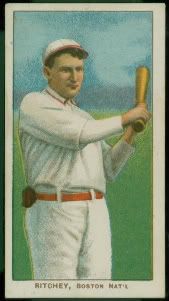 When I first began collecting Boston National T206's I didn't notice any difference in the Claude Ritchey backgrounds. Then while buying a Ritchey the seller pointed out to me that the one being offered was the tougher "Dove" variation. That caused me to immediately check all of my cards for this background. I ended up having a couple but it didn't seem like a definitive variation to me and that began my search for what made them different. I have read several different theories but in the end I think it's simply a matter of print quality. The T206 consists of a 6 color printing process. These colors are layered creating the multicolored backgrounds. 1)Yellow 2)Black 3)Brown 4)Blue 5)Dark Green 6)Red The bottom of the Ritchey background was first a layer of yellow, then blue, creating the light green. Look at the arms or the body in several of the pictures below where the registration is off slightly and you will see either yellow on top or blue on the bottom or the reverse where the colors don't overlap exactly. 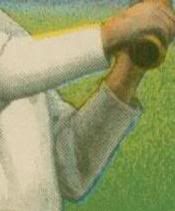 Then a layer of dark green was added on top of that. This I believe this is also the color that when layered on top of the blue sky gives the dark blue appearance of clouds that form the Dove. If you look at the progression of cards below you will see that the cards lacking in dark clouds also have far less dark green on the bottom of the background. The dark green layer stops at or just above Ritchey's elbow on the lighter cards and covers the entire light green layer on the darker examples. The darker the bottom the darker the clouds on top. 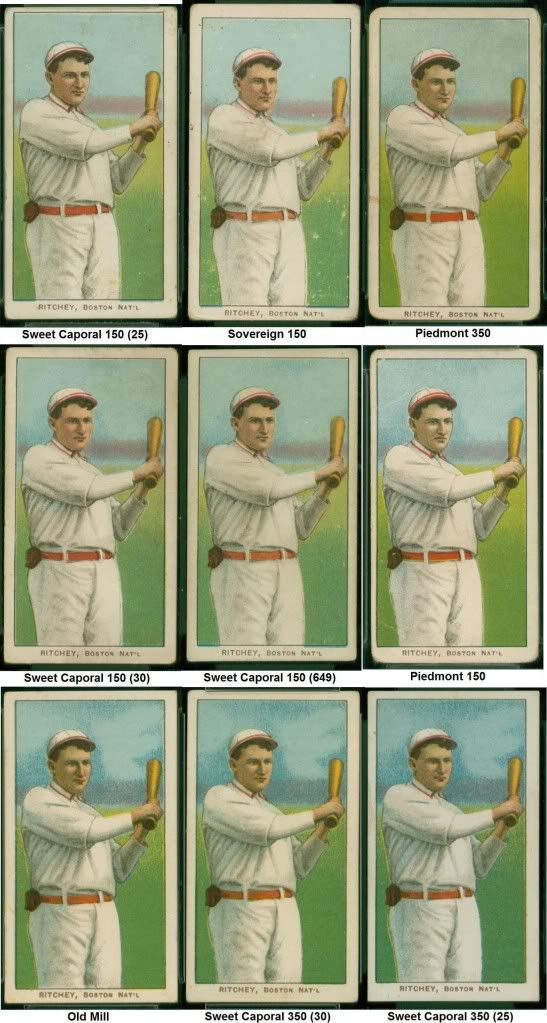 Most 150 series don't appear to have the Dove image and most 350 series do. As you will see from looking at the Piedmont 150 the Dove image is faint but it is there. I believe the printing process or quality control was improved between the two series bringing out what was already there. If this is redundant in anyway I apologize. I would love to hear anyone else's thoughts or opinions. |
|
#2
|
|||
|
|||
|
Tim - very interesting. I always thought the CW was that the printing quality on the later runs was less then on the previous ones.
|
|
#3
|
||||
|
||||
|
The black cap Matty has a blue halo around his head and upper torso that varies in intensity from card to card. It's very noticeable on some cards:
Last edited by toppcat; 05-14-2009 at 08:51 AM. |
|
#4
|
||||
|
||||
|
Tim, nice post.
I have often read that the T206 printing process contained six colors -- the ones you mentioned. I've always wondered where this theory comes from. I've looked at a lot of T206s under magnification, and the oft-repeated yellow-black-brown-blue-dark green-red set of colors just doesn't match up. I haven't examined Ritchey specifically, but if I looked at it I'd expect to see:
Looking at your Ritchey examples, it looks to me like the main printing difference between the 150 series and 350 series examples is in the Dark Blue ink layer. In the 150s, it's limited to the lower portion of the grass, Dark Blue over Yellow creating the darker green (whereas Light Blue over Yellow creates the lighter green grass). In the 350 series examples, the Dark Blue has been expanded, occupying much more of the grass section in the lower part of the card (more dark green grass) and extending up into the sky (creating the dark sky around the "doves"). This was a change done on the Dark Blue printing plate. Jamie |
|
#5
|
||||
|
||||
|
I would imagine that like the Ritchey, the Matty halo would be more pronounced on cards with a darker green bottom.
|
|
#6
|
||||
|
||||
|
Jamie-
I too thought there may be more colors to the printing process, but I wasn't able to find anyone else that thoughts so. So I used the 6 color process when looking at the cards that seems to be the consensus for now as to how the cards were produced. If there were additional colors that changes things. I still think there is a correlation between the dark green grass and dark blue clouds on the Ritchey. I think the same color application produced both. |
|
#7
|
|||
|
|||
|
My experience with observing several cards of Ritchey with these backs......
Piedmont 150 Sovereign 150 Sweet Cap 150 HINDU EPDG ....is that the doves are not visible in the pale blue sky. Although, under magnification, some of these cards have a very faint hint of the doves. The cards of Ritchey with...... PIEDMONT 350 Sweet Cap 350 Old Mill ....clearly show the doves. I attribute this phenomena to a better quality of Blue (and other) ink(s) used in the printing of 350 Series cards in 1910. TED Z |
|
#8
|
||||
|
||||
|
Ted-
My Piedmont 150 shows the Doves are present, just not as bold. An even better example of the Piedmont 150 is the one that sold in the recent Legendary Auction. 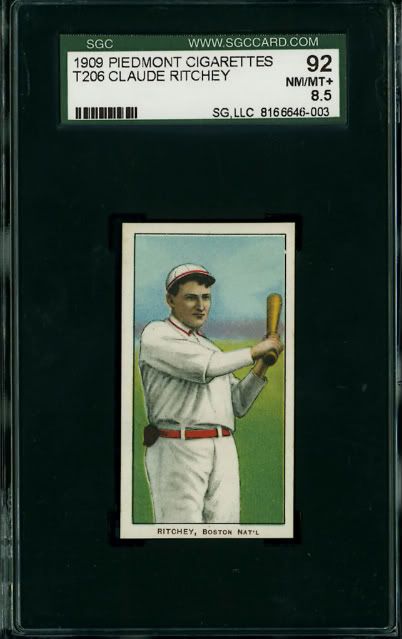 And if you think the difference is in the blue ink, do you not agree that there is a correlation between the dark green and clouds on the cards? Last edited by Abravefan11; 05-14-2009 at 09:43 AM. |
|
#9
|
|||
|
|||
|
JAMIE
You noted...... "I have often read that the T206 printing process contained six colors -- the ones you mentioned. I've always wondered where this theory comes from." Joseph Palmer Knapp (founder of the American Lithographic Co.) was an innovative force in the Lithographic printing industry and in 1895 he got a patent for his "6 cylinder color process". This process greatly improved the quality of color lithography; and I'd guess that Knapp employed it in the printing of all their sports and non-sports cards during the period of 1909 to 1916. TIM As I noted......although, under magnification, some of these cards (150 series) have a very faint hint of the doves. It appears as if the doves have always been part of the sky effect. And, their visibility is a function of printing inks. I arrange my T206 sets in a binder separating the successive series. And, I can tell you that by doing this, it becomes very obvious that the 350 series cards have a richer BLUE quality about them (than the 150 series cards). TED Z |
|
#10
|
||||
|
||||
|
Tim, the Legendary P150 Ritchey that you've posted raises an interesting set of possibilities.
In the REA Piedmont Plank thread I tried to explain a bit about how T206 printing plates were probably created (check out mkdltn's excellent posts as well). I won't post all of that again, but in a thumbnail, based on commercial lithographic processes circa 1910, it was a very simple procedure to create a production printing plate that included more than one copy of the same card -- hence the vertical column layout that seems to have predominated. The same processes also would have made it very simple to have any particular card be printed from multiple production plates. So for example, Claude Ritchey may have been printed from 2 or 3 or 4 or more printing plates, each having different configurations of cards but all containing Claude Ritchey or a column of Claude Ritcheys. I've come to believe that most T206s appeared on more than one printing plate in exactly this way. Many folks on this board are trying to figure out front-back combinations of T206 cards and are looking for correspondences between brands -- Ted several times has shown us his great sets of American Beauty, Broad Leaf, Carolina Brights, and Drum cards all having the same player on the front. But to some extent all of us who are interested in these correspondences are knocking our heads against a wall. There just aren't many clean rules of the kind that say, well, if a 350 series card can be found with EPDG, then it can also be found with Old Mill and Tolstoi. If cards only appeared on one printing plate, we'd see more of these kind of rules with regard to brand distribution. That we do not see that makes me believe that most T206s were indeed printed from multiple printing plates. To circle back to Ritchey, the variations in Dark Blue ink and "doves" and grass may not just be because of variations in ink levels with one printing plate. The variations may also be across several printing plates that included Ritchey, and across series (150 and 350) and the timeline of production. That there's a Piedmont 150 Ritchey with strong "doves" and plenty of Piedmont 150 Ritcheys with no doves at all seems to me to support this multiple plate theory. |
|
#11
|
|||
|
|||
|
Tim C,
I love seeing this Ritchey discussion! Great thread. I got into Ritchey so much some years back after the lengthy epdg discussion involving the doves among other things that I framed a Fan Craze Game box with the Fan Craze Ritchey affixed to the bottom and placed it in the middle of my office wall. ********** That SGC 92 Ritchey 150 Pied which you display does show a striking dove---a real beauty. It certainly makes me bend toward Jamie's multiple plate contention. I must admit that the part of me that wants to clear up T206 mysteries doesn't want to entertain this contention. Yet, Jamie's point that 'there's a Pied 150 Ritchey with strong doves and plenty of PIed 150 Ritchey's with no doves at all seems to me to support the multiple plate theory' cannot be swept away. And perhaps most disturbingly and even hauntingly accurate is Jamie's "there just aren't many clean rules...: |
|
#12
|
||||
|
||||
|
The multiple plate theory could very well be true. I'm not sure I'm 100% on board with it, but it definitely sounds good.
I would note that of all the examples of Ritchey's I have looked at, that only a few 150's show the Doves as strongly as the Legendary card I posted earlier. They are not the norm, but there are many Piedmont and Sweet Cap 150's with faint dark blue that you can see and show the Dove's were meant to be there all along. Along the same lines there are Piedmont 350's (note mine in the group of 9) where the Dove's don't show. However they are not the norm in the 350 series. I would suggest that the 150's that show the Dove's strongly were the best of the best. Maybe the first cards run off of just cleaned plates or something along those lines. When the 350 series begun ALC may have had some quality control review, cleaned up some of the images, improved ink quality, or even created new plates. For whatever reason this improvement brought out the Dove's though occasionally they would still not show up. I would consider these the very low end of the 350 run. If there was a greater variation in the 150 or even 350 series I would lean more towards the multiple plate theory. But the cards are pretty consistent with a few exceptions. Thanks for the imput from everyone so far. Last edited by Abravefan11; 05-14-2009 at 02:13 PM. |
|
#13
|
||||
|
||||
|
Tim, I think you're probably right that the more subtle variations of the Ritchey card are the result of either reduced Dark Blue ink levels in the press or worn plates that didn't hold the ink as well as they once did. There are countless countless T206s out there with these slight differences in printing, though not as noticeable as the "doves" here. But the difference between pronounced "doves" and barely noticeable "doves" is a difference in ink levels. The difference between the presence of the "doves," no matter how light, and no "doves" is a difference in printing plates, I'd suggest.
I think the multiple plate theory answers a number of different T206 problems, but it isn't the explanation for everything. I do think it's plausible though that with Ritchey we could be looking at a 150 series card that appeared on at least two plates, one with the "doves" and one without -- and perhaps the one lacking the "doves" entered production first and ran longer than the "doves" plate. Then when the 150 series cards were repeated as part of the 350 series, the same two plates were run again, but in inverse numbers -- more time in production for the "doves" plate and less for the "no-doves." Or perhaps there was a new plate made, or several, having the "doves." That would account for the differences in populations between the two series. Edited to add: Keep in mind that in lithography each color requires its own printing plate, so the differences we're discussing here applied only to one plate (in the set of 9 or 8 or 10 or whatever the number was that created the image of Ritchey), the one for Dark Blue ink. All the other colors seem to be identical for both "doves" and "no-doves" examples. So it could also have been the case that all Ritcheys, whether they have the "doves" or not, shared all their printing plates but one, and we see a difference today because Ritchey and this sheet of T206s had an alternate Dark Blue ink plate. Hope that makes sense. Last edited by jimonym; 05-14-2009 at 02:59 PM. |
|
#14
|
|||
|
|||
|
My 4 cards of Ritchey (three 150 Series and an EPDG) do not show even a hint of the the "dove's sky". Your theory,
Jamie, of multiple plates of a given T206 Subject, I think has a lot of merit. Another thought I might add.....American Litho. printed 1000's of Ritchey's during the 150 series press runs in 1909. As these plates wore, they replaced them with new plates somewhere along this process as they extended Ritchey into the 350 series press runs in 1910. These new plates included the "dove's sky". ![[linked image]](http://i603.photobucket.com/albums/tt113/zanted86/a4t206ritchey150.jpg) ![[linked image]](http://i603.photobucket.com/albums/tt113/zanted86/b4t206ritchey150.jpg ) TED Z |
|
#16
|
||||
|
||||
|
Jamie-
I think a major point you and I differ on right now is that you believe there two be two cards. One with Dove and one without. I think they all would have Doves had they been printed with the same quality. It's the poor quality that keeps the Dove from showing. Not the absence of a Dove on the stone. Does that make sense? Ted- Your Sweet Caporal is beginning to show the Dove though it is very faint. Notice the little bits of dark blue around Ritchey's bat and head and a little patch just off center in the top. Also look at how the dark green runs slightly higher on that card compared to the other three. This is the main point that I have been trying to make. The dark clouds that produce the Dove are proportional with the dark green on the bottom of the cards. The higher the dark green ink carries up the card, the more dark blue in the sky. I know nothing of the printing process but it seems as though the ink was applied from the bottom to the top and wasn't sufficient on the earlier cards. It ran out early thus not printing the entire image of the clouds. Once corrected through whatever change the entire image printed more consistently. Look at the difference in how high the dark green carries on these examples in relation to how dark the clouds are. 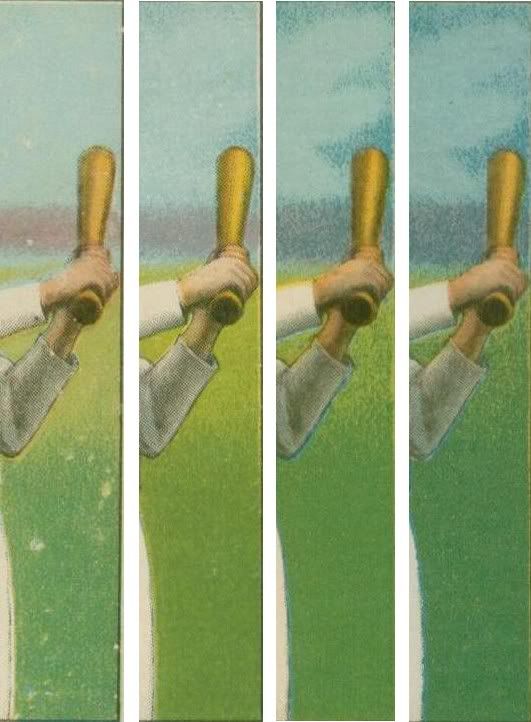 After looking at a lot of Ritchey's I have never seen one with dark green far up the bottom with no Dove. And I have never seen a Dove with the dark green lower on the card. But it is T206 and it could be out there. |
|
#17
|
||||
|
||||
|
Hi Guys,
I thought I was the only one who cared about Ritchey.... I remember starting a thread just like this one a few years ago...  I'll pull out my Ritchey's tonight and post them over the weekend. I'll pull out my Ritchey's tonight and post them over the weekend.Be well Brian 
|
|
#18
|
||||
|
||||
|
Hi Tim.
That does make sense. I don't know that you're right, and I don't know that I'm right. Nor do I know if you're wrong, or if I am. That's part of what makes T206s interesting. I do think though that if the Ritchey variations were due only to Dark Blue ink levels that we'd see some kind of similar variations in the cards that came from the same sheet. Not the occasional card with slightly more or less blue, but a lot of examples of a handful of other T206s that have a lot of gradation, as we see with Ritchey. It would be interesting, for myriad reasons, if anyone could point to others. Also, if we assume that Ritchey was printed in vertical columns, then it seems weird to me, although maybe it could be possible, that the Dark Blue ink would show such fluctuations from the bottom of the card to the top, over and over across the surface of the larger printing plate. I could see maybe the top card, or top couple, in a column not getting inked properly, but not the entire column of cards. And even if it was an ink distribution problem, wouldn't there be Ritchey cards with no dark green grass (meaning that no Dark Blue ink at all reached the paper)? Hope that's clear. Man, it's hard to use words to describe pictures. |
|
#19
|
||||
|
||||
|
Quote:
After posting about how the heavier color moves from the bottom to the top of the card last night and giving it a lot of thought I'm now wondering if it's just a resistance issue. If the ink in the T206 process took the path of least resistance and there was a varying amount of ink used in the application, a color such as the dark green (or dark blue) would show up always on the area meant for the heaviest amount of ink, and less often for the area meant for the least amount of that color. I haven't had the chance to look at as many examples of other T206's as I have the Ritchey but I think there are other cards that have variances but just not to the degree of the Ritchey, or with a contrast as noticeable as the Dove. Here are a couple of Marquard Hands At Thighs that have a similar background to Ritchey with a noticeable difference in the amount of dark green (or dark blue) ink. Again not as big a variance as Ritchey. 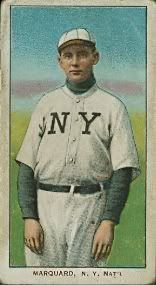 
Last edited by Abravefan11; 05-15-2009 at 12:07 PM. Reason: Grammar |
|
#20
|
|||
|
|||
|
Interesting work,Tim.
Looking back at your initial post, I do think that your point that the Ritchey dove card is not a definitive variation stands unswervingly. Your point that 'in the end I think it's simply a matter of print quality,' also is strong, although the definition of print quality may not be so simple now and may need to be fleshed out in response to the various 'speculations'/'theories' regarding multiple plates, new plates, ink distribution, resistance, etc. Admittedly, the corroborative data for these 'speculations'/ 'theories' is still very much fluid and in process and very difficult to use for fleshing out. Moving from the speculative/anecdotal to corroborative data may well require that most efficacious Zanidakean tool of the trade: survey. best, barry |
|
#21
|
|||
|
|||
|
Interesting work,Tim.
Looking back at your initial post, I do think that your point that the Ritchey dove card is not a definitive variation stands unswervingly. Your point that 'in the end I think it's simply a matter of print quality,' also is strong, although the definition of print quality may not be so simple now and may need to be fleshed out in response to the various 'speculations'/'theories' regarding multiple plates, new plates, ink distribution, resistance, etc. Admittedly, the corroborative data for these 'speculations'/ 'theories' is still very much fluid and in process and very difficult to use for fleshing out. Moving from the speculative/anecdotal to corroborative data may well require that most efficacious Zanidakean tool of the trade: survey. best, barry |
|
#22
|
||||
|
||||
|
Thanks Barry.
I'm extremely confident that all Ritchey cards were intended to have the same design and that all of the cards I have seen show this. It's just a matter of print quality as to how prominent certain features like the Dove stand out. Now figuring out what caused the great variance in this particular card and better understanding the printing process is another matter all together. As with many T206 issues there is always more to be learned. |
|
#23
|
|||
|
|||
|
Hi,
I felt obligated to post this. Hope this assist with the topic. Looks like the doves were meant to be. Craig |
|
#24
|
||||
|
||||
|
Craig, great card. Thanks for posting it. The pressman absolutely nailed the registration.
Well, the conundrum seems to be why most 150 versions of the card have no doves at all or only very light ones while most 350 versions of the card have quite obvious doves. I think the key word there is "most." If it were all one way or all the other, theories and guesses would be easier to prove. |
|
#25
|
||||
|
||||
|
Craig-
Thanks for posting. Great card. If it ever needs a new home...  The majority of 150's don't show the Doves at all or only some bits and pieces of them. The best one's that do like the high grade I posted from the Legendary auction or the proof that you posted are still not as deep in color as the 350's. Some 350's don't show the Dove like my Piedmont 350 but they are not the norm in the series. Most do have the deeper colors like Ted Z stated he has seen across the board in the 350 series. |
|
#26
|
||||
|
||||
|
Hi Guys,
Here are my Ritchey's: All are Piedmont 150's  Sweet Cap 150/649, EPDG, Old Mill  Hindu  Sweet Cap 150 fact 25  Sweet Cap 350 fact 30  Be well Brian |
|
#27
|
|||
|
|||
|
thsse are real beauts, Brian!
The Old and the final PSA 6 have two of the clearest pictures of the dove that i've ever seen. many thanks. Do you have a Weisnerian theory to add? all the best, bud barry |
 |
| Thread Tools | |
| Display Modes | |
|
|